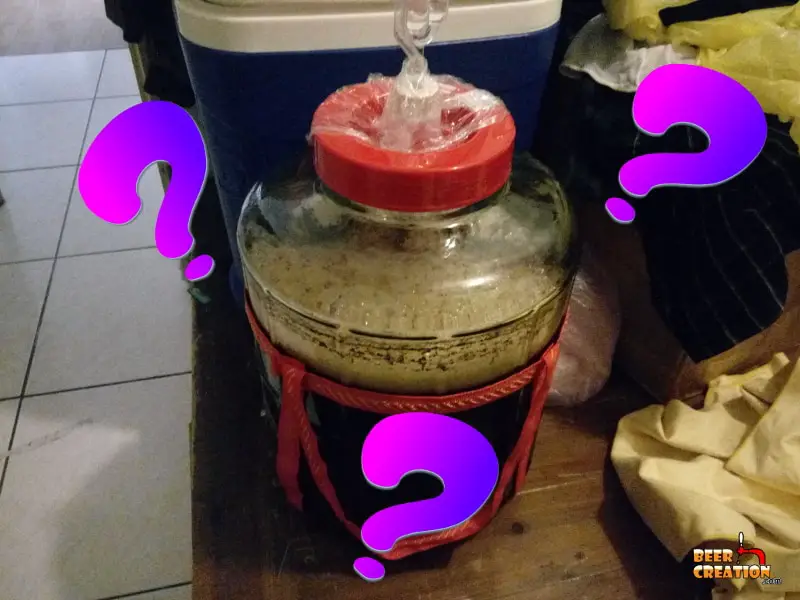The more I brew, the more I learn and the thing I learn the most is that process control and timing are key. What I’m working on at the moment is improving the look of my beer, so secondary fermentation is a great way to achieve this.
But of course, this gave me another question to answer, at what point during the fermentation process do I switch from the primary fermentation vessel into the secondary?
For the best results, you should rack your beer into a secondary fermenter soon after the most active stage of fermentation has finished. This can be as early as 2 days after pitching, but often much longer for some beers. Minimizing the transfer of waste material & oxygen is extremely important.
As with most of the lessons we can learn as homebrewers, there is a lot more information behind the short answer above. So, please read on to find out everything that I’ve been learning over the last couple of months about secondary fermentation.
New to homebrewing? Please feel free to read my ultimate guide to brewing beer at home and where to start.
What happens during beer fermentation?

OK, it’s probably not the most difficult question for the average homebrewer, nor the average Joe on the street. Fermentation is how we get alcoholic beer, right,
Yeah, of course, but there is also a lot finer detail which we should know as it helps us understand when to switch from the primary to the secondary fermenter.
Lag phase – Initially when you introduce your yeast to its new environment, the wort, it needs to take time to acclimatize. During this stage, the yeast is trying to ensure it has enough nutrients and to use oxygen present in the wort to build up its wall structure.
Some common issues which can affect the productivity of your yeast are simply pitching more yeast than necessary (although it’s really hard to overpitch yeast), so each yeast cell becomes under-nourished, and not providing enough nutrients in your wort for the yeast to work with.
The lag period, under ideal conditions, will take place anywhere from a couple of hours to up to sixteen hours after pitching.
Growth phase – This is the part of fermentation which is easiest to see as the yeast rapidly begins to consume the sugars (first glucose followed by fructose and then sucrose) and produce the by-products of ethanol and carbon dioxide.
At this point, you’ll see a foamy layer growing on top of your beer’s surface, called krausen. This phase is also when much of the desirable flavors are produced.
The growth phase can last from twenty-four hours to four days.
Stable phase – As nutrients become less abundant in your beer, the yeast will slow down their frenzy of feasting. By this stage, your beer will have most of the flavor and aroma it was designed for as all the compounds (fusel alcohols, esters, and sulfur) have been produced.
Although fermentation may be less apparent, it doesn’t mean that everything is over. Hopefully, your yeast is also absorbing all the nasty off-flavors usually produced during the main phases of fermentation, flavors such as diacetyl.
Your beer may enter a more stable period of fermentation from three days after pitching and up to tend days after adding the yeast.
When to transfer to the secondary fermenter
You need to wait to rack your beer into the secondary fermenter until the most productive period of fermentation is over. Basically, when you can see little activity on the surface of the beer and/or in your airlock, this is a good sign that the moment is right.
As mentioned above, the growth phase can take anywhere a few days to die down, so generally, you will be able to transfer your beer to the secondary fermenter between day 2 and day six for most ales and perhaps day 4 to day 10 if brewing a lager.
You can monitor the best time by taking specific gravity reading and making sure that the reading is fairly constant and close to your target final gravity. If you transfer the beer before you reach your final gravity, you can still reach it in the secondary fermenter.
Why transfer to a secondary fermenter?
There are a few reasons why you might want to use two-stage fermentation over just the single fermentation vessel.
#1 – Beer clarity
Here basically the aim is to produce a clearer beer just by allowing all the suspended material, yeast, and other compounds, to settle out of the beer.
This is normally done by waiting until fermentation has really finished in the fermenter and then you rack your beer into the secondary vessel to allow it to sit for a week or perhaps two to really clear out without the presence of the trub from the primary fermentation.
#2 – Flavor and aroma
Here the main aim is to get a superior tasting beer and to improve the aroma by allowing the yeast to finish the job of attenuation in a cleaner environment.
Here, you want to rack your beer pretty soon after your main krausen has started to sink back into your beer. As the beer moves from the growth phase to the stable phase, it’s going to be doing a slightly different job.
The idea behind using the secondary fermenter for this job is that you can allow your yeast to convert all the unwanted compounds it produced during fermentation, diacetyl, and the like, without the presence of all the dead material at the bottom of the fermenter.
In fact, there is a lot of evidence that shows that beer can take on the off-flavors found in the trub when exposed to it for too long. Generally, this is a problem for homebrewers simply because most of us use wide flat bottomed fermented which increases the surface area of the trub.
#3 – Bottling & kegging
Another reason to use a secondary fermenter is to remove the chance of transferring a lot of organic floating material into your bottled beer or keg.
Although many brewers use a bottling bucket, this is another method you can use, especially if you generally use carbonation drops for bottled beer.
Just by allowing the beer to sit in a secondary fermenter for a week or so and then bottling or kegging you can be sure you won’t get a mouthful of hops or risk clogging up your kegging equipment.
#4 – Yeast cake
Another reason to use a secondary fermenter is so that you can get at the yeast cake and rinse the yeast for your next batch more easily.
If you are a prolific brewer, then you may need to brew your next batch before the current one has finished the full process of fermenting. So, this is one way to overcome that problem.
#5 – Dry hopping
Dry hopping can be done in the primary or secondary fermenters, with the same effect. However, one reason to do it later in the fermentation process, or just after it’s finished and in the secondary fermenter is that the higher alcohol content and lower ph levels can suppress any bacteria that may be on the hops.
Nevertheless, the risk is quite low. If you want to learn more about whether you need to sanitize your hops, check out my article.
Secondary fermentation in a keg
Until now we’ve been talking mainly about carrying out secondary fermentation in a fermenter, i.e. a fermenting bucket or (better) a carboy. However, there is a third option which is fairly popular.
You can actually use a keg for your secondary fermenter, and even your primary fermenter if you want. One big advantage of carrying out secondary fermentation in a keg, especially just after the growth phase, is that you can naturally carbonate your beer. It’s basically acting like a big bottle
How and where should you store the secondary fermenter?
Just like for primary fermentation, you have to ensure that the conditions are ideal, so storing the beer in the right container and at the right temperature as well as in the right level of light is essential.
Storage
For secondary fermentation, it’s best if you choose a glass carboy over a plastic carboy or bottling bucket. This is simply because of the limited headspace you’ll get and the less porous nature of glass.
Although for your average light ale this isn’t going to be much of an issue when aging beers for several months it will be. Check out my article on the difference between plastic fermenting buckets and carboys for more information.
Temperature
Just like in primary fermentation, you need to keep the temperature range of both your brewing space and the internal temperature of the fermenting vessel just right!
This is to help the yeast finish the successful attenuation of the beer, although it’ll happen more slowly in the secondary fermenter if at all (depends when you racked the beer of course).
Another reason to do this is to limit the growth of any bacteria that may have gotten into your beer and could start multiplying to cause nasty off-flavors.
If you are starting an extended secondary fermentation period, especially for a lager, you will want to keep your beer in a fermentation chamber of some sort. Check out my extended article on how to keep your fermenter cool.
UV Light
Another very important thing to consider, especially when using a glass carboy, is that you want to keep it out of direct sunlight. If you don’t do this it could lead to the death of your yeast cells and also a bad-tasting beer.
How long should secondary fermentation take?
Assuming that your beer is at the right temperature, out of direct light, and in an oxygen-free zone, you can leave it in the secondary fermenter for longer than you may think. Below is just a rough guide based on generic beer types.
| Beer type secondary fermentation period | |
|---|---|
| Light ales | 1-2 weeks |
| Amber ales | 2-3 weeks |
| Dark ales | 3-4 weeks |
| Light lager | 7-8 weeks |
| Amber lager | 3-4 months |
| Dark lager | 9 months |
| High ABV ale | 9-12 months |
| Barleywine | 9-12 months |
Do you need an airlock on your secondary fermenter?
Yes, as mentioned before, exposing your beer to the air isn’t something you want to do. Although your airlock may not see a lot of activity in terms of bubbles, it’s still going to be providing a vital air barrier which will stop air from getting in and still allow the slow build-up of CO2, and some other more unwanted gases, to escape safely,
Another option, of course, is to use a blow-off tube with one end just poking into your fermenter and the other in a container of sanitizer. As long as you block air getting in and allow gases to escape, you’ll minimize the risk to your beer.
How to rack to the secondary fermenter without oxidation
Unlike when you are racking your wort into the primary fermenter, you don’t want to add additional oxygen to your secondary fermenter. Oxidation is a big issue during this process and can leave your beer tasting and smelling like old cardboard, among other things.
One method is to transfer the beer from primary to secondary fermenter in a completely closed system using carbon dioxide to force a suction effect from one container to the other.
Do you really need to use a secondary fermenter?
Well, this really is the debate that divides the brewing community. Some brewers are avid secondary fermenters and some see it as a dangerous waste of time.
The major arguments from each camp are those that believe leaving your beer in contact with the waste material which has settled into the base of your primary fermenter will eventually negatively affect your beer and those who think oxidation is the bigger danger.
The fact of the matter is that most commercial brewers, my friend Tom included, don’t use secondary fermenters and they can produce excellent beer. This being said, they also don’t brew in the same type of equipment the average homebrewer does.
Most commercial brewers use large conical-shaped fermenters which make it easier to remove the yeast due to their design and also have a lot less beer in contact with the waste material at the bottom.
I have heard of different tests which have kind of suggested that oxidation is much more common than off-flavoring from contact with the trub. However, it can be said that if you can minimize the risk by racking your beer through a closed system, you’ll also remove the risk of contaminating your beer through autolysis.
At the end of the day, whether you use secondary fermentation really depends on the equipment you have to hand, the type of beer you are brewing, and your own preference.
Alternatives to classic secondary fermenters
After talking with a friend who is a commercial brewer for a local craft brewery, I really think a good option is to move from plastic and glass fermenters, either primary or secondary, and go towards a stainless steel conical design.
So, if you want to cut out one more task from your brewing process, then perhaps we should all get SS Brewtech Bucket fermenter.

You can find it here on Amazon, or you can also help support another company by getting it here at morebeer.com.
I hope you have found this post as interesting to read as I found it interesting to research.
Don’t forget to check out my other articles which are all written about questions I’ve come across why trying to brew better beer, happy brewing.





